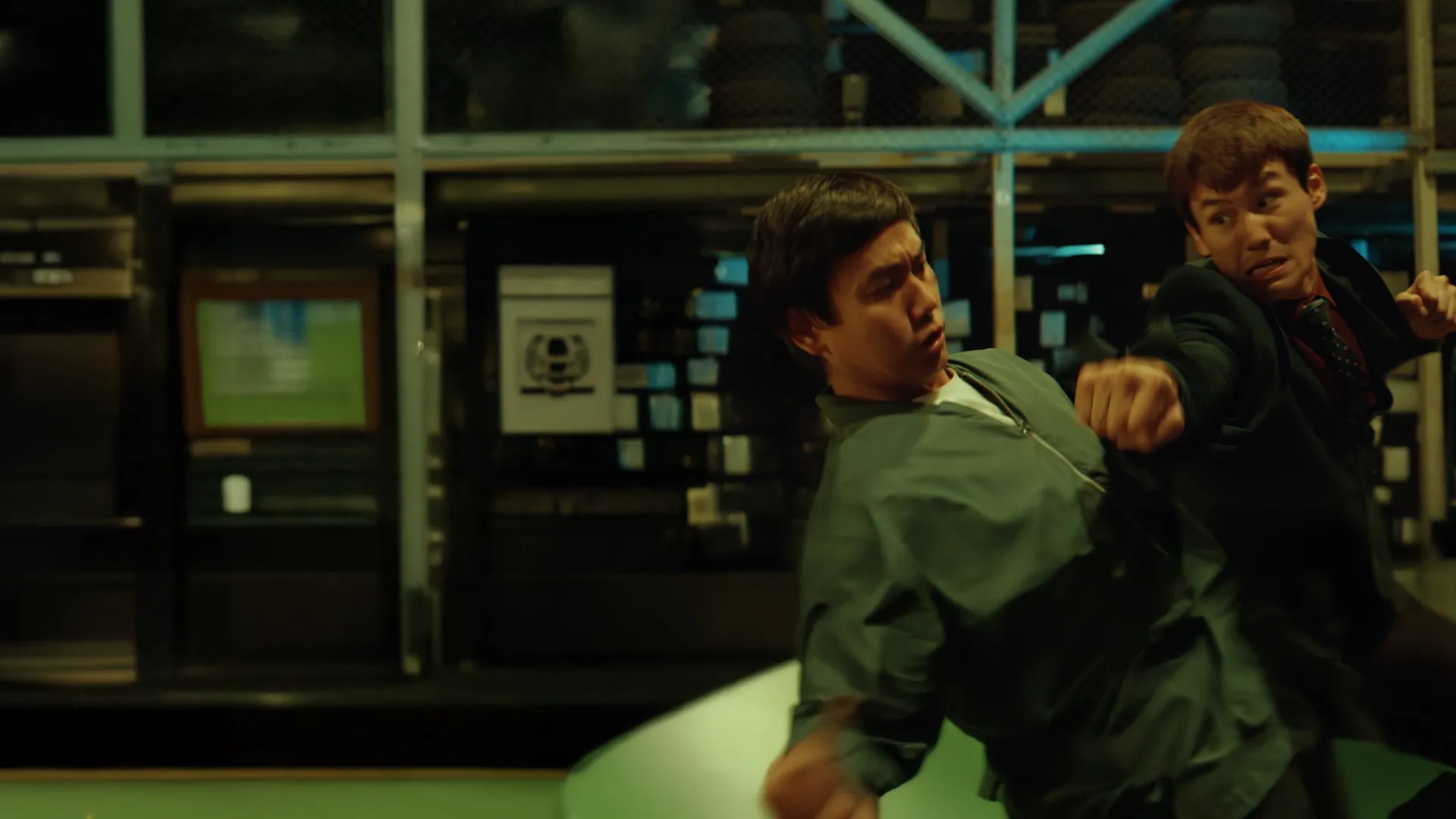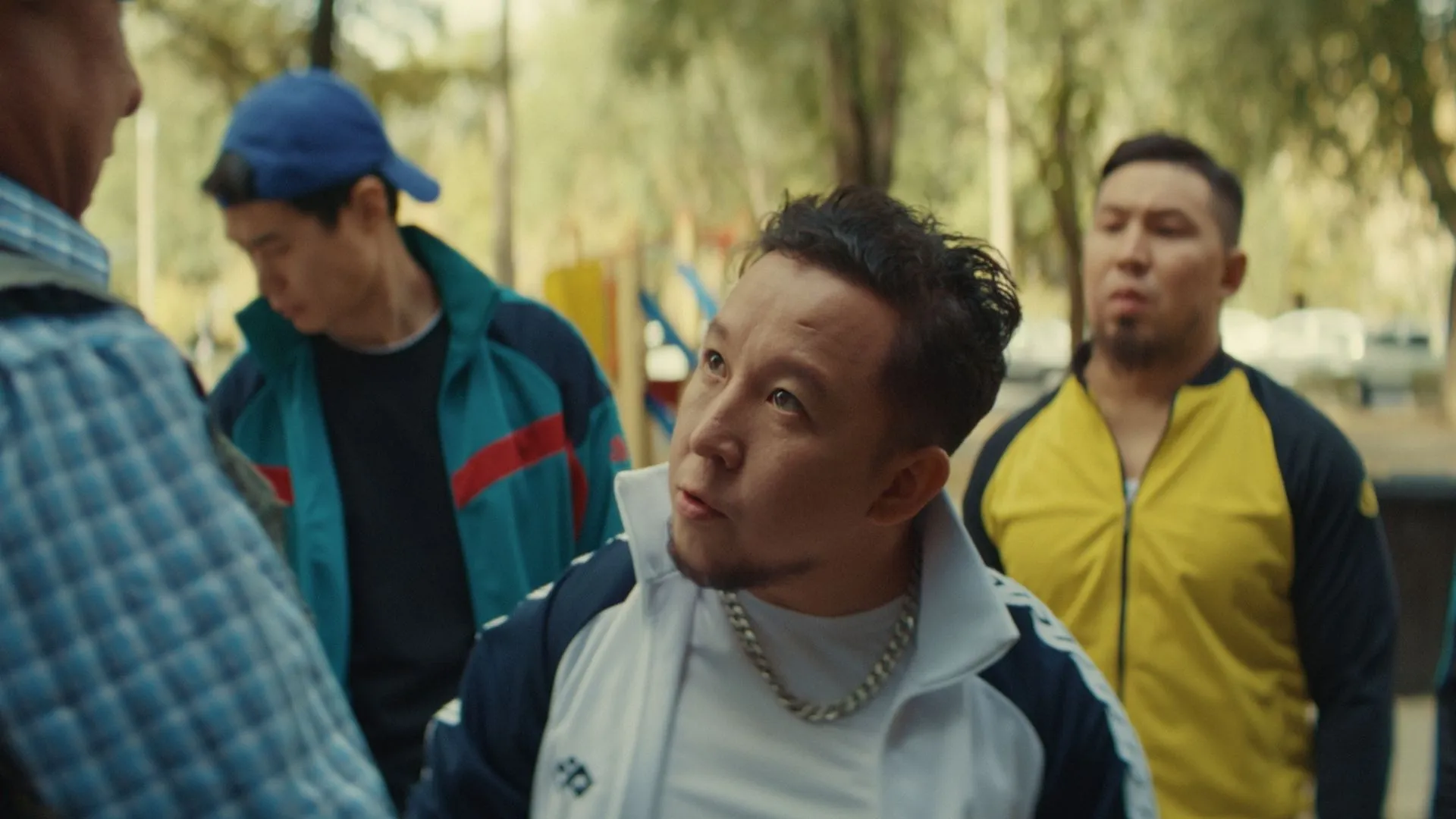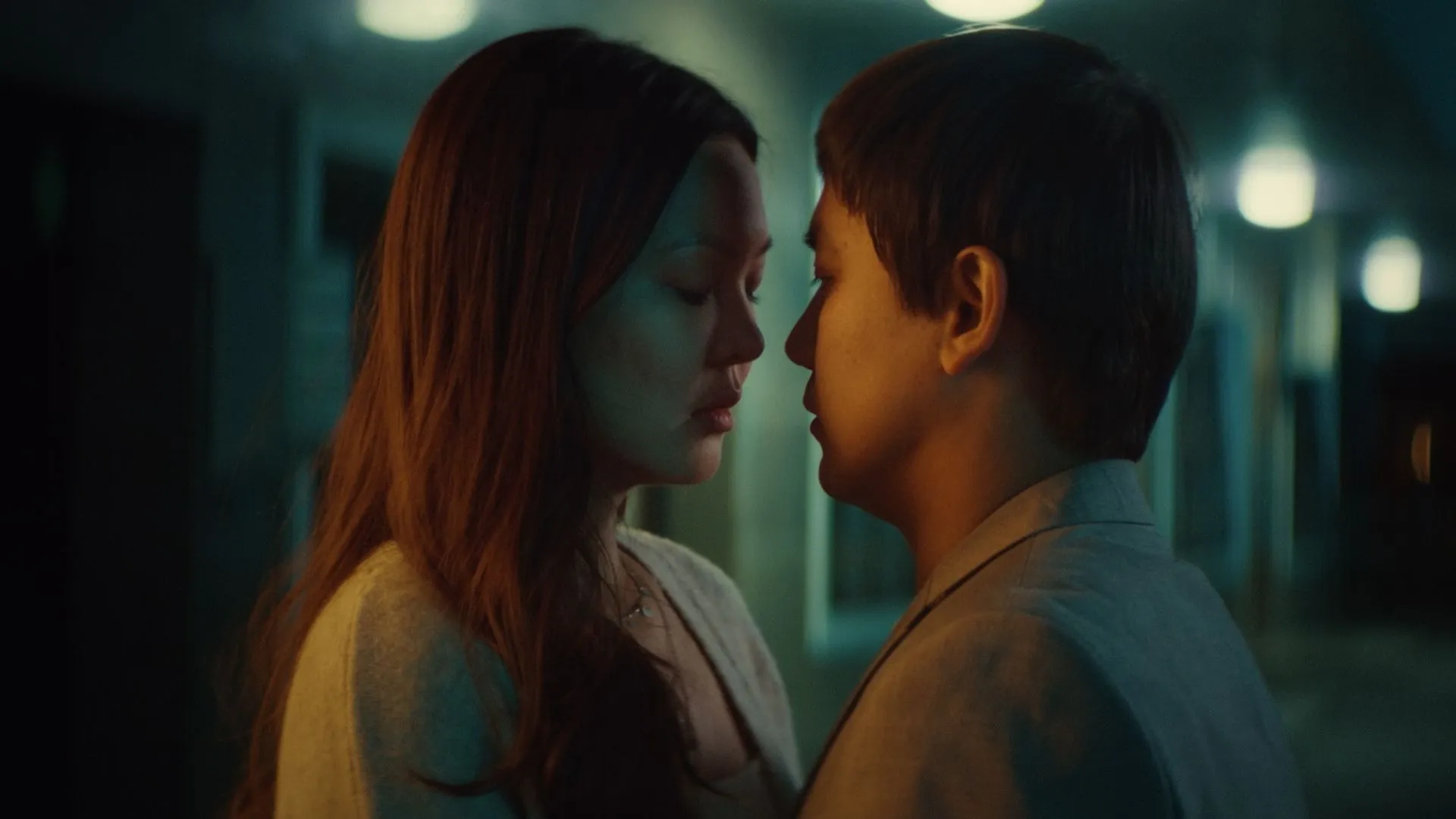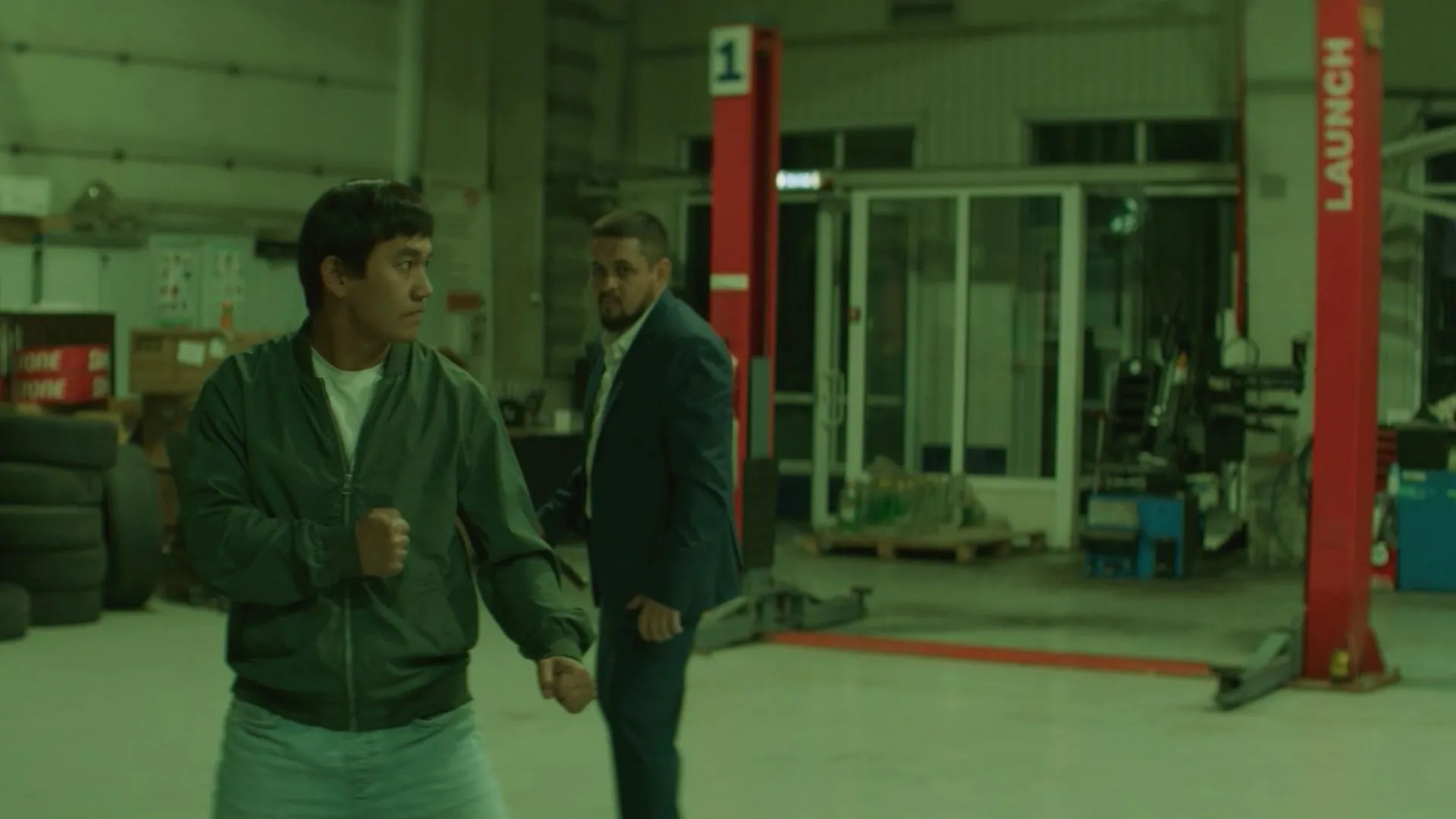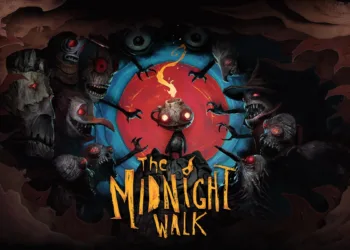Timuchin’s arrival in Almaty marks the collision of humble roots and high-flying ambition. Born in a remote village where every sunrise paints the vast Kazakh steppe, he carries a singular dream: to join the city’s police force after growing up on Jackie Chan films. His loyalty to Uncle Samat—who runs a modest produce stall—anchors him in family duty, while his blossoming affection for Alua adds warmth amid the chaos. Together, these relationships ground a narrative that could otherwise drift into spectacle alone.
Aman Ergaziyev’s direction and Anuar Turizhigitov’s screenplay strike a balance between affectionate tribute and fresh cultural voice. Vivid market scenes pulse with local color: wooden crates brimming with apricots, the chatter of bargaining customers and the distant call to prayer weaving through background chatter. Yet every moment hints at something larger—a wistful homage to 1990s Hong Kong thrillers, reimagined on Kazakh streets.
Lighthearted stunts blend with genuine peril, and the film’s playful spirit never feels forced. Through Timuchin’s wide-eyed optimism, the movie charts a journey across physical terrain and emotional thresholds, inviting audiences from both East and West into its spirited fold.
Blueprint of the Hero’s Path: Structure in Motion
Timuchin’s dusty countryside origins give way to Almaty’s neon bustle the moment he steps off the bus. His wide-eyed stroll past teeming bazaars and street vendors underscores his outsider status—much like a newcomer in a parallel-cinema drama confronting social hierarchies. When the police academy doors close in his face, the film establishes two stakes at once: his dream deferred and the financial strain he bears for Uncle Samat’s modest fruit stall.
A single act of courage—chasing down a pickpocket—carries the weight of a Bollywood hero’s first moral test. That chase, shot in long takes that capture swirling crowds and clattering carts, recalls the kinetic energy of Mumbai’s alleyway pursuits in mainstream Hindi blockbusters. The rescue of Samal introduces Alua via a playful song-in-montage feel: quick cuts between cheeks flushing over tea and Timuchin’s shy glances amid lantern-lit arches. When Arsen’s thugs retaliate, each set piece—from market rooftops to a kaleidoscopic amusement-park fight—builds like the escalating song-and-dance-turned-battle sequences in masala cinema, blending spectacle with character growth.
The warehouse finale transforms conveyor belts and rusted car shells into extensions of Timuchin’s body, channeling his resourcefulness as a form of visual symbolism. Props become lyrical partners: spare tires double as shields, tailpipes as staffs. The choreography’s playful rhythms mirror the intercutting of fight and close-ups in Indian action thrillers that prize both emotion and bravura stunt work.
By film’s end, Timuchin stands amid glinting metal and cardboard boxes, his uniform buttoned and resolve firm. His journey from hopeful recruit to streetwise protector respects the homage at play, while asserting a narrative structure grounded in local color and global action traditions.
Faces in Motion: Portrayals and Personas
Timuchin (Timur Baktybayev) carries a warmth that recalls the hopeful protagonists of parallel Indian dramas. His shy optimism surfaces in every hesitant smile before battle, yet when punches start flying, his body becomes a canvas of expressiveness. Baktybayev times his comic missteps—tripping over crates, mistaking a coat rack for a training dummy—with the precision of Bollywood’s lighthearted moments, then pivots seamlessly into moments of dramatic resolve when family or Alua’s safety is at stake.
Alua (Janelle Sergazina) functions as more than love interest; she embodies the supportive catalyst seen in many contemporary Hindi films where heroines balance tenderness with agency. In action scenes, she ducks behind produce stands or throws first punches when needed, her confidence complementing Timuchin’s earnest energy. Their chemistry feels earned—glances exchanged over steaming tea pots carry as much weight as any choreographed fight.
Uncle Samat stands in for the mentor archetype familiar to global audiences, from Bollywood’s guru figures to Hong Kong’s kung fu masters. His good-natured teasing, followed by quiet concern when Timuchin risks everything, provides emotional grounding.
Arsen and his henchmen tap into the territorial-thug trope common in masala cinema, yet their threat feels credible through disciplined staging. Their coordinated assaults, set to a pulsing score, mirror the efficient choreography of international action trends, making each clash feel both culturally specific and universally thrilling.
Stunt Poetry: When Street Meets Screen
The film’s city chase unfolds like a dance across Almaty’s rooftops and stalls. Timuchin vaults over stacked crates and leaps between galvanized rooftops, turning everyday market clutter into a kinetic obstacle course. The camerawork alternates between sweeping aerial shots—recalling the expansive vista in a grand Indian chase—and close, handheld coverage that immerses viewers in every scrape and misstep. Each bounding stride feels intentional, as if the city itself choreographs his path.
At an amusement park, the action embraces playful absurdity. Timuchin and his pursuers weave through carousel horses and tilt-a-whirl cars, hurling plush toys and overturned game booths as improvised weapons. Fast-cut editing during the roller-coaster collision injects urgency, while lingering long takes on spinning rides allow the audience to track hand-to-hand counters. This shifting rhythm—one moment breathless, the next purposefully measured—mirrors contemporary Bollywood thrillers that fuse spectacle with character-driven stakes.
The fruit-stand rescue foregrounds both humor and raw combat. As Timuchin scrambles to save Samal’s purse, he grabs tomato crates and a coat-rack dummy, repurposing them into shields and training targets. A sudden pratfall leaves him momentarily exposed, eliciting laughter before he delivers a solid kick. This interplay of slapstick timing and genuine impact echoes the signature style of 1990s Hong Kong martial cinema, yet it’s rooted here in Kazakh authenticity.
The climactic warehouse brawl elevates every creaking conveyor belt and trailing extension cord into a prop with purpose. Tailpipes become makeshift escrima sticks, spare tires roll unpredictably underfoot, and rusted car doors swing like trapdoors. The scene’s spatial choreography lets Timuchin dart through steel columns and sliding partitions, while his opponents—real martial-arts practitioners—move with precision. The result is an ensemble stunt showcase where each combatant’s intent reads clearly, echoing the communal energy of multi-opponent sequences in South Asian action fare.
Behind the scenes, the absence of visible wirework or digital fakery highlights the performers’ commitment. Occasional imperfect landings and fleeting grimaces attest to real physical risk. This dedication aligns with a growing global insistence on authenticity, where stunt teams from Mumbai to Almaty favor practical effects and genuine contact over seamless postproduction fixes.
Laughter in the Midst of Mayhem
Playful antics ground the film’s larger-than-life ambitions. Timuchin’s coat-rack dummy mix-up—whacking it like a training target before realizing it’s just a hanger—recalls Bollywood’s fondness for slapstick surprises in everyday settings. A pratfall onto a pile of apricot crates sends produce flying in colorful arcs, offering a lighthearted counterpoint to looming threats.
Flirtation montages unfold with tea-stall banter and candid market strolls, scored by rhythmic percussion that nods to parallel-cinema’s use of folk motifs. Quick cuts between Timuchin’s shy smiles and Alua’s amused glances mirror Hindi romances where shared laughter cements emotional connection.
Emotional stakes rise when Uncle Samat lands in the hospital, transforming Timuchin’s playful bravado into resolute action. That shift echoes dramatic pivots in global action dramas, where a family member’s peril justifies heroic leaps. Watching Timuchin guard his uncle’s bedside, the film uses warm lighting and lingering camera frames to signal his growth from wide-eyed dreamer to guardian.
Comedy and danger alternate with assured pacing. One moment, Timuchin juggles watermelons as improvised grenades; the next, he stands over a fallen thug, chest heaving, eyes fierce. This tonal fluidity—common to cross-cultural thrillers—keeps viewers invested.
Romantic tension blooms amid chaos. After a misfired compliment at a fruit cart, Timuchin ducks under a spilled basket of apples, turning embarrassment into endearment. Such humorous missteps deepen their bond, proving that even amid fast-paced combat, moments of genuine heartland warmth can shine through.
Icons Across Borders: Homage in Motion
Timuchin’s fluid strikes and acrobatic counters feel like a love letter to classic Hong Kong stunts. A rooftop tumble recalls the gravity-defying leap in Rumble in the Bronx, while a tight corridor brawl mirrors the refrigerator duel from Who Am I. Even the slow-motion pool-table collision nods to Police Story 2. Yet these echoes arrive naturally, woven into Kazakhstan’s own cityscape rather than pasted atop it.
His habit of invoking Chan by name serves as character detail rather than a wink to the audience. It reveals Timuchin’s earnest belief that heroes shape our destinies, mirroring themes in parallel Bollywood dramas where idolatry drives personal transformation. That tension—embracing an icon’s spirit without losing oneself—emerges when he pauses mid-fight, glancing skyward as if seeking guidance before delivering a decisive blow.
By shifting Hong Kong–style kung fu onto Almaty streets, the film charts a cultural exchange in motion. Local landmarks—ornate teahouses, open-air markets, sweeping mountain views—become arenas for signature stunts, demonstrating how martial-arts cinema travels and adapts.
Aware of its own ambition, the movie rarely aims for perfect imitation. It pauses to let Timuchin stumble, reminding viewers that devotion involves trial as well as triumph. In doing so, it honors its inspiration with humility, choosing celebration over carbon copy.
Crafting the Canvas: Visual & Aural Design
Nursultan Bazarbay’s lens captures every punch with crystalline clarity, framing Timuchin’s movements in long takes that echo parallel-cinema’s respect for unbroken reality, then shifting to sweeping drone shots that reveal Almaty’s skyline as a silent witness. The color palette oscillates between earthy market tones—rusted reds, sun-baked ochres—and cooler steel grays in industrial spaces, grounding stunts in tangible locales.
Composer Zhasular Norgaziyeu scores fights with driving percussion patterns that pulse like Bollywood dance beats, while romantic scenes unfurl under gentle strings and native folk motifs. These traditional Kazakh themes weave into modern rhythms, reinforcing emotional highs without overpowering the action.
Editing under Aman Ergaziyev’s guidance keeps the 80-minute runtime taut, avoiding narrative padding by trimming excess reaction shots and maintaining momentum between dialogue and stunts. Transitions swing from seamless match-cuts in fight sequences to playful jump cuts during outtakes, which roll in the end credits as a reminder of the team’s joy.
Full Credits
Director: Aman Ergaziyev
Writers: Anuar Turzhigitov, Alisher Nazarov
Producers: Timur Baktybayev
Cast: Timur Baktybayev, Yerkezhan Toktar, Zhanelle Serzhanina, Kuat Khamitov, Talgat Duisenov
Director of Photography (Cinematographer): Nursultan Bazarbay
Composer: Zhasulan Nurgaziev
The Review
Kung Fu Rookie
Kung Fu Rookie delivers genuine energy and cultural flair, transforming Almaty’s streets into a playground of inventive stunts and heartfelt moments. Timur Baktybayev’s earnest performance and the crew’s commitment to practical choreography pay tribute without imitation. Moments of slapstick warmth balance high-stakes combat, while local color and rhythmic editing keep scenes engaging. Though it occasionally stumbles under its ambitions, the film remains an entertaining showcase of cross-cultural action.
PROS
- Energetic stunt work grounded in vibrant Kazakh locales
- Creative use of everyday props in choreography
- Warm chemistry between Timuchin and Alua
- Clear, dynamic cinematography with drone-enhanced vistas
- Concise pacing keeps the 80-minute runtime focused
CONS
- Action rhythm occasionally swings between rushed and slow
- Comic moments can undercut rising tension
- Lead’s martial technique shows room for refinement
- Simple plot structure feels familiar at times
- Finale wraps up with little buildup








































